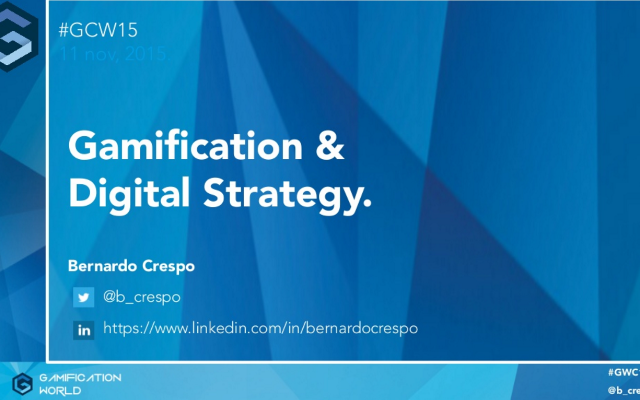In the last five years there are two topics in which I have been focusing on in a really passionate way: Digital Strategy and Gamification. I went through this topic last week at the 2015 Gamification World Congress in Barcelona and here is a transcription of my speaking note.
“the holy grail of Gamification is to unlock the secret of motivation and engagement. Maybe Digital Strategy has the key” — @b_crespo
Gamification and Digital Strategy: The Secret of Engagement
The reason why games are so present today in our lives is just because we are completely lost as human beings. Maybe games are taking us back to a moment in our lives where we were still connected to our essence as human beings: childhood. This is perhaps the reason why games are the #1 category in terms of downloads on mobile apps. Additionally, mobile apps have overcome webs in terms of the overall time spent on digital, according to KPBC (Mary Meeker, May 27, 2015). Mobility and gaming account for a huge stake of our digital lives.
CEOs and digital gurus worldwide are coming to a point of mutual understanding about the necessity to focus on how digital is changing the way companies and users address the trouble of communicating with each other. It is right now, in this new digital era where offline and online are no longer separate vectors of the same reality. Connecting companies and users through Online and offline realities is the conundrum and the challenge of this new playground. And honestly, I have been discussing this topic with hundreds of decision makers for the last 4-5 years. Is there a common field of improvement to naturally join all those forces? I pretty much feel that there is and Gamification has a lot to offer to this reasoning.
When dealing with Gamification we are tidying up the forces of engagement and motivation. That is exactly what marketers are looking for every single day at their work, and not only marketers, also CIOs, CTOs, CEOs and even CFOs and CHROs. Nowadays everyone agrees that finding the key to unlock the driving forces of consumer and personal behavior is the right way to enhance ongoing and persistent performance. And, for the first time, digital allows these forces to be easily tracked. Truth be said and quoting my friend Sergio Maldonado, digital customer behaviour is nowadays easy to track and not completely traceable.
[Figure 1 – Amplifying digital scope of gamification]
Why applying constraints to Gamification in terms of digital strategy? If we are able to track outside-in and inside-out traffic from our own media assets, do we have to design our gamification strategy with a limited approach to our own media channels? Or is it possible to conceive the scope of gamification considering also earned and paid media?
I truly believe that if gamification is about interactions, we should opt for a much broader field of application: social media strategy, content strategy, organic positioning, onboarding and ongoing tactics, and last but not least, performance and paid media. The figure no.1 shows a new scope of gamification and the possibilities of measuring and optimizing our initial approach.
Gamification and human behaviour: The Secret of Motivation
If we know that bringing back the child that we all hold inside of us is the hack, what does it mean for us that the new child’s brain is no longer the same as it is used to be? What is the new problem to address if our brains are changing every time we interact with UX enriched interfaces –i.e. gamified environments?
If have a close look at the way communication and conversations have evolved throughout history, we see that we are getting back to basics. Is conversation the “New Black”? Let’s say that we have moved from the ancient Greek Poetry of oral tradition to a new social media interconnected way of sharing information and knowledge. Moreover, if we translate conversation into the jargon of this new digital era, a new keyword arises in a natural way: “interaction”. [See slide 16].
It might sound kind of old-fashioned to translate interaction on digital media as conversation and my point here is that social media and games are bringing the topic of interaction on a global scale. The 4th edition of the Gamification World Congress #GWC15 is the perfect forum to discuss the possibilities of applying lessons learned not only from games but also from social media interactions. Nowadays and thanks to really valuable frameworks such as Octalysis,Gamification Model Canvas, Gamified.uk typologies or even more simple frameworks such as Bartle’s Game user types, we know how to drive emotions, trigger tactics, design playful creatives and segment users by game behavior. The question is: Are all those frameworks universal and unchangeable approaches if our minds are being continually reshaped by the use of game mechanics? I am going to answer this question quoting two different empirical experiments.
A research released in spring 2015 (Diankun Gong et Al., 2015) on the effects of active video games on the attention and motor abilities of active gamers shows a clear connection between gaming and neuroplasticity. As a matter of fact, this experiment proved the possibilities of literally molding our neo-cortex by the use of active video games. The results of this research show that games –active video games, to be more precise- are reshaping our brains, increasing our possibilities of attention and even our neuromotor skills.
Another interesting experiment conducted at the University of Utrecht by Christof van Nimwegen (van Nimwegen, 2008) about the effects of Computational interface on problem-solving tasks shows a set of inspiring insights. Van Nimwegen confronted various groups of students through problem-solving tasks. He used different computational interfaces for the classical Missionaries and Cannibal test. Some groups went through the problem-solving task using much flatter UX design -colored balls and boxes instead of Missionaries and Cannibals or Wolves and sheeps. Over the course of the experiment and after several iterations, the group dealing with less enriched interfaces was able to improve performance and read trouble context challenges in a sharper way. The group assisted with more user-friendly interfaces, clearer design and problem explanations was much more productive in the initial iterations. However, they became less creative and more likely to find end-of-game situations over the course of the experiment.
My reading of these experiments is that every time we launch or evolve a new gamified approach, the attention of our users might be eroded or reshaped -neuroplasticity and gamification. As game designers or gamification strategists, we should be addressing the problem of overuse. Once we know that gamification works as a really powerful way of approaching user’s engagement and motivation, the intense use of game mechanics might be taking us to a position in which those powerful tools (points, virtual currencies, badges, levels, progress bars, etc.) would be on the verge of exhaustion. Wouldn’t it be like killing the goose that laid the golden eggs? I do think so.
I am not trying to offer a limited approach to gamification. There are hundreds of great professionals worldwide –most of them attending the Gamification World Congress every year– whose approach to Gamification is much broader than a digital-only view. However, . I am sure that the same results and lessons learned would have been obtained in a non-digital environment.
Why do we usually fall in over-use of game mechanics? My view on this topic is really simple. Basically, segmenting your users by game typologies ex anteis a hassle, mainly due to lack of information and/or variables of segmentation by game use or behavior. This leads us to a situation in which initial approaches to Gamification, although scientifically pre-tested, are usually hard to evolve (design issues, CMS rigidities, plot limitations, wrong mechanics, etc.) Therefore, we end up pushing forward the initial approach to a certain point of fatigue. Might it be the reason why 80% of users disengage after the first weeks?.
Most companies decide to keep on releasing new challenges, introducing extrinsic reward mechanisms or intensifying direct rewards in order to reactivate users, instead of evolving their initial approach and considering other ways of engaging users when explicit playful designs are not applicable on a mass scale. This stubborn approach usually concludes in a failure and simultaneously obliterates the potential engagement that game mechanics inherently have when used in a wise and smart way.
In my opinion, in order to preserve the enormous possibilities of smart-designed and well-deployed game mechanics in terms of engagement and motivation –thus conversion- a new concept has to emerge: “Gamification Social Responsibility” or “GSR”. I feel that it is in the hands of game designers, gamifiers and Gamification strategists to curate the use of game mechanics. Are we hinting at the creation of a new position, the so-called “Gamification curator”? I do not know. The only thing I have for sure is that experts on Gamification should go through a deep reflection in order to preserve the potentiality of game mechanics. Here are some of my thoughts on how GSR may be put into practice:
- Searching for a Gamification adviser professional when applying game dynamics and mechanics to solve business problems.
- Generating a degree of sensitivity in game designers about the consequences of short-term loss of neural connections.
- Accepting that users’ attention and curiosity may be diminished by the lack of effort in performing tasks enhanced by the use of game mechanics.
And, without doubt, one must feel responsible for the change as well as the results when using Gamification. This message is for everyone trying to apply Gamification to his/her business. Not only to gamifiers but also to creative agencies and adventurous marketers that feel attracted to the idea of exploring this trending keyword.
To summarize all the issues in this post, here are 7 takeaways regarding Digital Strategy, Gamification and Neuroplasticity:
- If we know that engagement with a purpose is the key issue, why not using Gamification within the scope of the Digital Strategy as a whole?
- If intrinsic rewards sustain engagement in the long run, why not applying the focus on dynamics from earned to paid media?
- If Gamification engages people on emotional level, why not using powerful digital analytics to keep track of emotional engagement?
- If Gamification is about player-centric design, why not using digital audiences to segment players by goals and ambitions on the go?
- If evolving the initial approach is hard to accomplish, why don’t we use testing and personalization tools to optimize the game?
- If Gamification is a source of structural change, shouldn’t we be responsible for the change we are facilitating to people?
- To summarize, over-use of Gamification mechanics might take you to the dark side of the force.
Acknowledgement: To Tania Asa for your fresh ideas.
Sources: Diankun Gong et Al., 2015, Enhanced functional connectivity and increased gray matter volume of insula related to action video game playing. Diankun Gong, Hui He, Dongbo Liu, Weiyi Ma, Li Dong, Cheng Luo & Dezhong Yao. | Van Nimwegen, 2008, University of Utrecht, The paradox of the guided user: assistance can be counter-effective. Christof van Nimwegen supervised by Herre van Oostendorp. | Nicholas Carr, 2010, The Shallows: What the Internet Is Doing to Our Brains. W W Norton & Company. | Burke, Brian, 2014,Gamify: How gamification motivates people to do extraordinary things. Gartner
Article by channel:
Everything you need to know about Digital Transformation
The best articles, news and events direct to your inbox
Read more articles tagged: Featured











